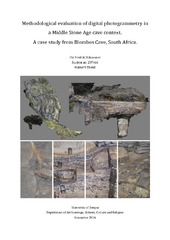Methodological evaluation of digital photogrammetry in a Middle Stone Age cave context. A case study from Blombos Cave, South Africa.
Master thesis

Åpne
Permanent lenke
https://hdl.handle.net/1956/16225Utgivelsesdato
2016-11-22Metadata
Vis full innførselSammendrag
In this thesis, I investigate how digital photogrammetry can be used as a standalone method of visual and spatial recording at the South African Middle Stone Age site of Blombos Cave (BBC). The method has become popular in the field of archaeology, thanks to advances in computer power and the introduction of powerful, automated and intuitive software solutions. The dark, confined and at times fragile nature of a cave, however, often presents a particularly challenging subject for many recording methods. This includes photogrammetry because it relies on a large number of high-quality photographs to generate a detailed 3D model of a site. Most methods of recording are only capable of producing data on current phenomenon; however, as photogrammetry generates data on the basis of images, it can generate information on things that no longer exist. If and how a photographic archive can be used to generate spatial information about archaeological features that no longer exist is therefore investigated. During the work with this thesis, a successful strategy and workflow was developed; and this allows for the recording of BBC and its surrounding landscape. The strategy only utilizes equipment that is already part of the excavation project. Also, a strategy to successfully obtain new spatial information from archive images is also established and presented. To evaluate the spatial quality of the newly recorded data, a comparison is performed against the data collected using laser scanning in 2011. The results show that the photogrammetric dataset has similar spatial accuracy and has produced a complete record. To determine the relevance of introducing this new method, a methodical comparison and theoretical evaluation of the data I created, is also performed. Different methods of spatial and visual recording currently employed at BBC are specifically evaluated to determine if photogrammetry should be implemented fully into the recording strategy, and what role it might fulfill. Digital photogrammetry is found to provide datasets that contain more and better information than more conventional recording methods, such as drawing, photography and laser scanning. In this thesis, I specifically argue that photogrammetry produces data sets containing a less abstracted representation of the real world; a trait that may prove very useful during the post-excavation phase, and highly beneficial when communicating with the wider public. The data sets I present can also valuable in multidisciplinary research and as a tool to mediate discoveries and archaeological contexts for future researchers. The thesis provides strong arguments for implementing digital photogrammetry as a recording method of archaeological cave sites. A functional, best-practice" photogrammetric workflow was therefore made; both to tackle particular challenges at Blombos Cave, but also to provide advice for others, of how to best approach cave environments.